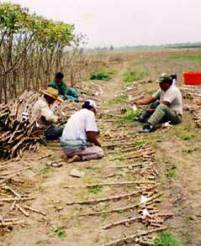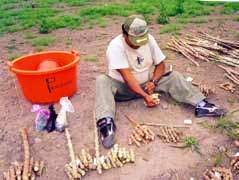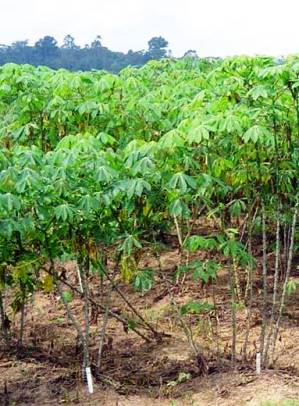Regeneration guidelines for cassava
|
View regeneration guidelines in full (in PDF) Also available in the following languages: |
The information on this page was extracted from:
Jorge M.A. 2008. Regeneration guidelines: cassava. In: Dulloo M.E., Thormann I., Jorge M.A. and Hanson J., editors. Crop specific regeneration guidelines [CD-ROM]. CGIAR System-wide Genetic Resource Programme, Rome, Italy. 9 pp.
Before reading the regeneration details for this crop, read the general introduction that gives general guidelines to follow by clicking here.
This guideline provides information for the regeneration of field collections of cultivated species.
Introduction
Cassava (Manihot esculenta Crantz) is the only domesticated species of a genus which contains 98 species and belongs to the Euphorbiaceae family. It was first domesticated 7000 years ago (Allem 2002) in the lowlands of South America, probably in the Amazon Basin. Introduced into Africa by the Portuguese in the 16th century and into Asia in the 18th century (Hillocks 2002; Onwueme, 2002), today it is found all over the tropics and subtropics.
It is a very hardy perennial crop with the ability to grow on land where drought is frequent and in soils low in nutrients, where cereals and other crops do not grow well. Cassava is vegetatively propagated from nodal cuttings (stakes) in field production systems, while all of the wild species are seed propagated in nature. It is also a monoecious and predominantly cross-pollinating species with viable seeds in the genotypes that flower. Controlled pollination and seed production are mostly used for the development of new varieties in breeding programmes. Seed populations can also be collected from cassava field collections to be stored and preserved as future sources of genetic information. Wild types are more difficult to regenerate in field genebanks than cultivated landraces (M. esculenta); most of them are perennial and difficult to regenerate through cuttings. Cassava is mainly conserved as live plants in field genebanks, but it can also be maintained as seeds, in vitro and by cryopreservation. About 20 000 accessions are being conserved worldwide, the largest collections being held at CIAT (Colombia), EMBRAPA (Brazil), IITA (Nigeria), and in Ghana and India (Ng and Ng 2002).
|
|
Choice of environment and planting season
Climatic conditions
- Cassava grows well between 30°N and 30°S in areas where annual rainfall is more than 750 mm a year, temperatures above 18°C and low to medium altitude (1,500–2,000 m).
- It is sensitive to frost but tolerant of long dry periods, soils with low pH, high aluminium and low fertility.
Planting season
- If water is available either through irrigation or well-distributed rainfall, the crop can be planted at any time of the year, preferably at the beginning of the warm season (growth slows during cold weather).
- In places where rainfall is seasonal and irrigation is not available, delay planting until rains are reliable.
Preparation for regeneration
When to regenerate
- Cassava has a growing cycle of between 9 and 24 months, depending on the genotype and the environmental conditions.
- It is best to regenerate within 18–24 months, when most plants complete their growth cycle, to avoid lodging from excessive growth and build-up of pests and diseases.
Preparation of planting material
- Prepare stakes from healthy plants, identified earlier in the season before leaves drop off when pest and disease (especially virus) symptoms and other foliar diseases are apparent. Also inspect roots for pest and disease symptoms.
- To prepare the stakes, select the mature portion of the stem, avoiding the top green stems and the bottom section of the plants (see photo below).
- Make stakes at least 20 cm long with at least 4–5 nodes with viable buds to ensure crop establishment and cut them at a right angle. Do not place the stems on a hard surface to cut them, as this can damage the nodes, reduce their quality and provide
- entry points for pathogens and insect pests.
- Label stake bundles immediately after cutting with accession number and date of harvest (see photo below).
- Treat the stakes with a mixture of broad spectrum insecticide and fungicide (see photo below).
- Add zinc sulphate in regions where zinc is limited in the soil.
- Take care to avoid mixing of genotypes.
- Handle stems with care to prevent bruising and peeling.
 |
 |
 |
|
Cassava stakes of good quality for planting. (photo: IITA genebank) |
Laying out the cassava stakes for labelling (photo: INIA, Peru – Ll. Rios) |
Labelling and disinfesting the cassava stakes (photo: INIA, Peru – Ll. Rios) |
Field selection and preparation
- Field plots should be uniform in fertility, with light textured, deep, well-drained soil and as free as possible from noxious weeds.
- Avoid stony, clay or waterlogged soils.
- In sandy soils, apply minimum tillage to conserve soil, organic matter and moisture and reduce soil erosion.
- In shallow or hard soils, increase top-soil volume per plant for better establishment.
- In poorly drained soils, make ridges or mounds to reduce waterlogging.
- Allow an overlapping period in the field of at least six months between the ‘old’ and the newly planted field to ensure that materials that did not germinate can be replanted and provide a constant supply of planting material for research programmes.
- Secure and protect the field against theft, vandalism and damage by animals.
Method of regeneration
Planting layout, density and distance
Plot size and spacing will depend on the size and purpose of the collection, land availability and demand for planting materials.
- Group germplasm according to vigour, plant height, branching habit and tendency to lodge, establishing at least three groups: high, intermediate and low vigour.
- Establish a distance of 2.2, 1.5 and 1.0 m between plots for high, intermediate and low vigour groups respectively, to avoid mixing up planting materials at harvest.
- Space plants 1.0–1.5 m apart if evaluations are to be made simultaneously, or closer if the collection is solely for germplasm maintenance (0.75–1.0 m within the row and 1.0 m between rows) to minimize weed growth and land requirements.
- Maintain a minimum of five and an optimum of ten plants per accession to ensure adequate survival and supply of planting material for weak genotypes.
|
|
Planting method
- Plant stakes directly in the ground (so that half or two-thirds of the stake is covered) or in soil ridges or mounds, vertically or at an angle, or even bury them horizontally about 5cm below the soil surface (see photo). The local planting practice of experienced cassava growers in the area can also provide a good guide.
- Identify plots very carefully, putting a plastic tag in the first plant of the left hand row of the plot. Place an extra label on a plastic, metal or strong wood in front of the plot.
- Draw a field map of the collection immediately after planting, with each accession located on the map, including both plot numbers and accession numbers.
- Replant missing plants one month after planting.
Crop management
Fertilization
- Fertilization is usual y not required for the sole purpose of germplasm maintenance. However, add manure at land preparation (e.g. cow dung or poultry manure) if necessary.
- Apply NPK 15:15:15, depending on the soil analysis, about 8 weeks after planting, around the plant, not touching the stems or leaves.
Weed management
- Ensure adequate control of weeds pre-emergence by ploughing and harrowing the soil or applying pre-emergence herbicides before planting, and post-emergence with herbicide applications, inter-row weeders or regular manual weeding.
- Weed as often as necessary to avoid competition between plants. Often weeding will be required at least four times per season, depending on the environment.
- Critical times are during the initial four months or until leaves form a canopy and weed growth is suppressed.
Irrigation
- The soil must be moist at planting, otherwise irrigation is required.
- If irrigation is not available, it is important to plant the collection at the beginning of the wet season when rain is reliable.
Pruning
- Prune plants about nine months after planting when using high densities or if growth is excessive.
- Note that pruning can create wound entries for pests and pathogens, and can spread them from one plot to another by way of the cutting instrument and workers’ clothing.
- Dip cutting instruments in a detergent solution between plots to destroy bacterial and viral pathogens on the surface.
Rotation
- Plant germplasm on new land every generation cycle.
- Rotate with grass or leguminous crops to break the cycle of certain root pathogens and prevent land degradation.
Common pests and diseases
America has the greatest diversity of cassava pests, followed by Africa and then Asia. Damage in Africa is often high due to the lack of natural predators of pests. Damage is greatest in the dry season or in dry areas with low or irregular rainfall. The green mite (Mononychellus tanajoa) (America and Africa) and the mealybug (Phenococcus manihoti and P. Herreni) cause major damage in Africa; whiteflies (Aleurotrachelus socialis and A. aepim), hornworm (Erinnyis ello), stemborers (Chilomina clarkei), burrower bugs (Sternocoelus manihoti and Tropidozineus fulveolus), thrips (Frankliniella williamsi) and lacebugs (Vatiga manihoti, V. illudens and Amblydtira machalana) are a problem in America, while scales (Aonidomytilus albus), termites and grasshoppers are widely reported. Amongst the main cassava diseases there are the complex of cassava mosaic diseases (CMD) caused by the African cassava mosaic virus (ACMV), the East African cassava mosaic virus (EACMV) and by the South African cassava mosaic virus (SACMV); and the cassava brown streak virus (CBSV) in Africa. In South America, the main viral diseases are caused by the cassava common mosaic virus (CsCMV) and by the cassava frogskin virus (CFSV). Other diseases like cassava bacterial blight (CBB) or those caused by fungi, like cassava anthracnose and root rot, are important worldwide.
Contact plant health experts to identify symptoms and recommend appropriate control measures.
Pest and disease control
- Select healthy planting material. Do not take cuttings from plants that had leaf chlorosis, shoot tip die-back, cankers, fungus patches or streaks on the stems.
- Treat cuttings with pesticides and fungicides before planting, and the plants during the growth stage when necessary.
- Rogue and burn diseased plants regularly during the growth season (if it does not compromise the survival of a specific accession).
- After harvest, destroy discarded stems and roots that have disease symptoms or pest contamination.
- Use natural enemies against cassava pests as much as possible. Complement by applying appropriate pesticides as and when necessary.
- Weed the field regularly.
Harvesting
- Harvest stakes at the end of the growing season (this guide does not refer to any root or seed harvesting, dealing only with the vegetative propagules), usually 12–18 months after planting, depending on the cultivars and environment. In some environments most of the leaves wil have dropped, but in others, a leaf canopy remains at maturity.
- Be careful to identify the stem cuttings from each plot.
Post-harvest management
- Store stakes in a well-ventilated and shaded cool place until planting or in case they need to be replanted (keep some extra planting material for a while until the collection is established).
- Take care during the harvesting and subsequent handling of the stakes not to bruise them.
- Extend storage time (not recommended for collections) with longer uncut stakes tied in bundles pre-treated in pesticide, at 70–80% RH and 20–23°C.
- Stakes can also be stored (also not recommended for collections) buried in the ground for several months, with the basal side down or horizontally; regular watering is required to avoid excessive dehydration.
- Stakes or cuttings also store well for weeks in polythene bags in drier areas and/or during the dry season.
Monitoring accession identity
- Check that varieties are as originally described. When plants reach maturity, check against the latest descriptor list (Fukuda et al., 1998) (or compiled when the accessions were first described) and, if available, photographs of the accessions.
- Check regularly for mixtures due to handling mistakes: look for uniform characteristics, such as colours of young apical leaves (expanded and non-expanded), petiole, cortex and external stem as well as pulp, cortex and external root colours; flowering and branching types, pubescence of young leaves, shape of the central lobe, internodes distance (leaf scars), storage root peduncle and surface texture.
Documentation of information during regeneration
- Regeneration site name and map/GPS reference.
- Name of collaborator.
- Field/plot reference.
- Accession number; population identification.
- Source of cuttings.
- Number of generation or previous multiplication or regeneration (if generation is not known) since acquisition of germplasm.
- Preparation of planting material (pre-treatments).
- Method of planting, date and spacing.
- Field layout used.
- Field management details (watering, fertilizer, weeding, pest and disease control, stresses recorded, others).
- Environmental conditions (altitude, precipitation, temperature, soil type and others).
- Number of plants established.
- Days from planting to flowering (note: this will only be important if seed collection is anticipated).
- Harvest date and method.
- Number of plants harvested.
- Quantity of cuttings harvested.
- Agronomic evaluation; agro-morphological traits recorded.
- Comparisons with reference materials (record any identification numbers or references of any samples taken from this regeneration plot).
- Any evaluation undertaken at harvest.
- Post harvest (describe any relevant procedures).
- Others.
References and further reading
Adekunle AA, Dixon A, Ojurongbe J, Liona P, Muthada L, Adisa S. 2004. Growing Cassava Commercially in Nigeria. USAID, ICS-Nigeria and IITA. 22 pp. Available from: http://www.cassavabiz.org/agroenterprise/ent%20images/casava%20illust%20guid%20book.pdf. Date accessed: 1 August 2008.
Allem AC. 2002. The origins and taxonomy of cassava. In: Hillocks RJ, Thresh JM, Bellotti AC, editors. Cassava: Biology, Production and Utilization. CABI Publishing, Wallingford, UK. pp. 1–16.
Alves AC. 2002. Cassava botany and physiology. In: Hil ocks RJ, Thresh JM, Bel otti AC, editors. Cassava: Biology, Production and Utilization. CABI Publishing, Wal ingford, UK. pp. 67–89.
Bellotti AC. 2002. Arthropod pests. In: Hillocks RJ, Thresh JM, Bellotti AC, editors. Cassava: Biology, Production and Utilization. CABI Publishing, Wallingford, UK. pp. 209–235.
Bioversity International. 2009. Key access and utilization descriptors for cassava genetic resources. Available here
Calvert LA, Thresh JM. 2002. The viruses and virus diseases of cassava. In: Hillocks RJ, Thresh JM, Bellotti AC, editors. Cassava: Biology, Production and Utilization. CABI Publishing, Wallingford, UK. pp. 236–260.
Cock JH. 1985. Cassava: physiological basis. In: Cock JH, Reyes JA, editors. Cassava: Research, Production and Utilization. UNDP/CIAT. pp. 33–62.
De Goes M, Sias-Costa CIR, Guedes AC, Morales EAV, Second G. 1999. Cassava – a Brazilian model for the field maintenance of germplasm. In: Engelman F, editor. Management of field and in vitro germplasm collections. IPGRI, Rome, Italy. pp. 10–12.
FAO. 2004. Production Year Book. FAO, Rome, Italy.
Fukuda WMG, Guevara CL. 1998. Descritores morfologicos e agronomicos para a caracterizacao de mandioca (Manihot esculenta Crantz). EMBRAPA-CNPMF Documentos 78. EMBRAPA-CNPMF, Cruz das Almas, Brazil. 38 pp.
Fukuda WMG, Costa IRS, Vilarinhos AD, Oliveira RP. 1996. Banco de germoplasma de mandioca: manejo, conservacao e caracterizacao. EMBRAPA-CNPMF Documentos 68 EMBRAPA-CNPMF, Cruz das Almas, Brazil. 103 pp.
Fukuda WMG, Costa IRS, Silva SO. 2005. Manejo e conservacao de recursos geneticos de mandioca (Manihot esculenta Crantz) na Embrapa Mandioca e Fruticultura Tropical. Circular Tecnica 74. 4 pp.
Hillocks RJ. 2002. Cassava in Africa. In: Hillocks RJ, Thresh JM, Bellotti AC, editors. Cassava: Biology, Production and Utilization. CABI Publishing, Wallingford, UK. pp. 41–54.
INIA. 2005. Descriptor de yuca (Manihot esculenta). Programa Nacional de Investigación en Recursos Genéticos y Biotecnología, PRONIRGEB, INIA, Lima, Peru. 52 pp.
Iglesias CA. 1999. Field maintenance of cassava germplasm. In: Engelman F, editor. Management of field and in vitro germplasm collections. IPGRI, Rome, Italy. pp. 5–9.
Lelhner D. 2002. Agronomy and cropping systems. In: Hillocks RJ, Thresh JM, Bellotti AC, editors. Cassava: Biology, Production and Utilization. CABI Publishing, Wallingford, UK. pp. 91–113.
Ng NQ, Ng SYC. 2002. Genetic resources and conservation. In: Hillocks RJ, Thresh JM, Bellotti AC, editors. Cassava: Biology, Production and Utilization. CABI Publishing, Wallingford, UK. pp. 167–177.
Onwueme IC. 2002. Cassava in Asia and the Pacific. In: Hillocks RJ, Thresh JM, Bellotti AC, editors. Cassava: Biology, Production and Utilization. CABI Publishing, Wallingford, UK. pp. 55–66.
Acknowledgement
We acknowledge the useful contributions and suggestions from Dominique Dumet, Soyode Folarin and Olaniyi Oyatomi, International Institute for Tropical Agriculture (IITA), Nigeria; Llerme Rios Lobo, Instituto Nacional de Innovación Agraria (INIA), Peru; Wania Fukuda, Empresa Brasileira de Pesquisa Agropecuária (EMBRAPA), Brazil; and Francisco Morales, International Center for Tropical Agriculture (CIAT), Colombia.
These guidelines have been peer reviewed by Nyat Quat Ng, consultant, Malaysia, and Clair Hershey, private consultant, USA.








Leave your comments
Post comment as a guest